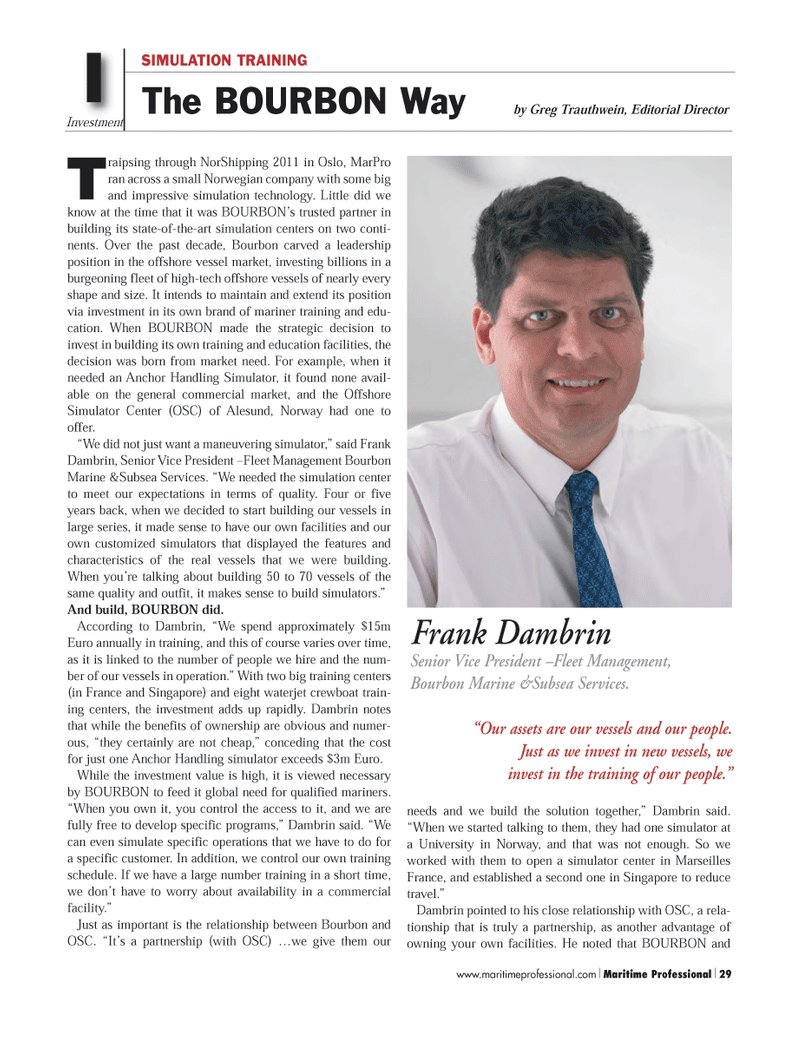
Page 29: of Maritime Logistics Professional Magazine (Q3 2011)
Maritime Security / Maritime Training & Education
Read this page in Pdf, Flash or Html5 edition of Q3 2011 Maritime Logistics Professional Magazine
www.maritimeprofessional.com Maritime Professional 29 Traipsing through NorShipping 2011 in Oslo, MarProran across a small Norwegian company with some big and impressive simulation technology. Little did we know at the time that it was BOURBON?s trusted partner in building its state-of-the-art simulation centers on two conti- nents. Over the past decade, Bourbon carved a leadership position in the offshore vessel market, investing billions in a burgeoning fleet of high-tech offshore vessels of nearly every shape and size. It intends to maintain and extend its position via investment in its own brand of mariner training and edu- cation. When BOURBON made the strategic decision to invest in building its own training and education facilities, the decision was born from market need. For example, when it needed an Anchor Handling Simulator, it found none avail- able on the general commercial market, and the Offshore Simulator Center (OSC) of Alesund, Norway had one to offer. ?We did not just want a maneuvering simulator,? said Frank Dambrin, Senior Vice President ?Fleet Management Bourbon Marine &Subsea Services. ?We needed the simulation center to meet our expectations in terms of quality. Four or five years back, when we decided to start building our vessels in large series, it made sense to have our own facilities and our own customized simulators that displayed the features and characteristics of the real vessels that we were building. When you?re talking about building 50 to 70 vessels of the same quality and outfit, it makes sense to build simulators.? And build, BOURBON did. According to Dambrin, ?We spend approximately $15m Euro annually in training, and this of course varies over time, as it is linked to the number of people we hire and the num- ber of our vessels in operation.? With two big training centers (in France and Singapore) and eight waterjet crewboat train- ing centers, the investment adds up rapidly. Dambrin notes that while the benefits of ownership are obvious and numer- ous, ?they certainly are not cheap,? conceding that the cost for just one Anchor Handling simulator exceeds $3m Euro. While the investment value is high, it is viewed necessary by BOURBON to feed it global need for qualified mariners. ?When you own it, you control the access to it, and we are fully free to develop specific programs,? Dambrin said. ?We can even simulate specific operations that we have to do for a specific customer. In addition, we control our own training schedule. If we have a large number training in a short time, we don?t have to worry about availability in a commercial facility.? Just as important is the relationship between Bourbon andOSC. ?It?s a partnership (with OSC) ?we give them our needs and we build the solution together,? Dambrin said. ?When we started talking to them, they had one simulator at a University in Norway, and that was not enough. So we worked with them to open a simulator center in Marseilles France, and established a second one in Singapore to reducetravel.? Dambrin pointed to his close relationship with OSC, a rela-tionship that is truly a partnership, as another advantage of owning your own facilities. He noted that BOURBON and IInvestment The BOURBON Way by Greg Trauthwein, Editorial Director SIMULATION TRAINING Frank Dambrin Senior Vice President ?Fleet Management, Bourbon Marine &Subsea Services. ?Our assets are our vessels and our people. Just as we invest in new vessels, we invest in the training of our people.? MP #3 (18-33):MP Layouts 8/17/2011 4:11 PM Page 29

 28
28

 30
30
